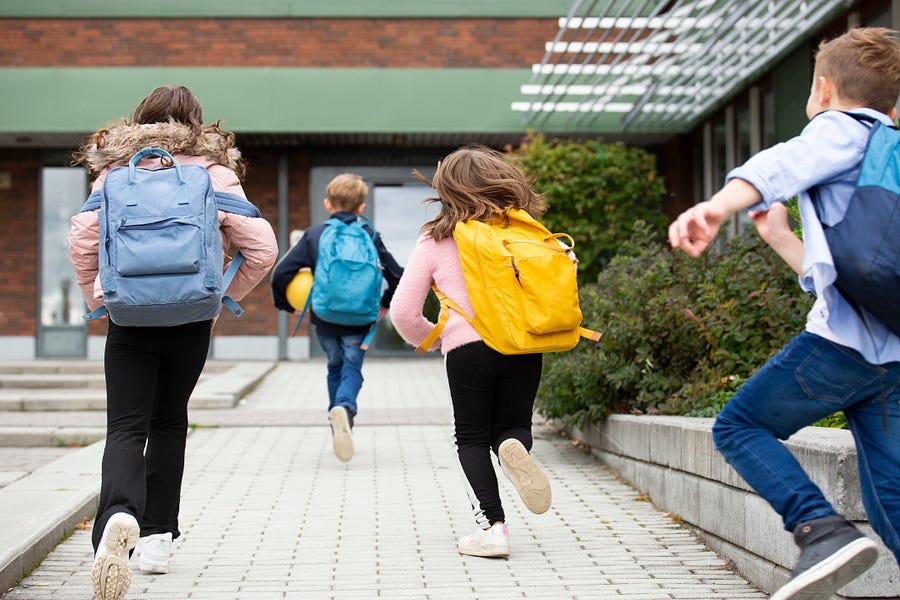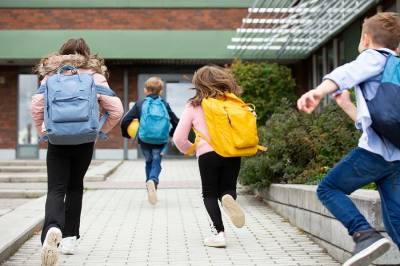The pandemic has mostly receded from America’s schools. School mask mandates are rapidly melting away, and even New York City is finally allowing students to show their faces. After a fresh wave of January school closures in cities like Chicago, Atlanta, and Detroit, shutdowns are at long last (mostly) an ugly memory. The curtain has fallen on COVID theater. While things are frequently still hinky when it comes to cafeterias, extracurriculars, and other school day routines, normal is well within sight.
In its wake, the pandemic has left a trail of disruption and academic devastation. We saw dramatic declines in test score performance. Researchers have reported that students lost between one-third and one-half of a year in reading, and between a half-year and a full year in math—with the largest losses associated with more remote learning. In Texas, the first state to publish a full set of spring 2021 student test results, the share of students on grade-level in Algebra 1 plunged from 62 percent in 2019 to 41 percent in 2021. Similar trends held across the land, with McKinsey reporting substantial increases in race- and income-based achievement gaps.
Meanwhile, two years of off-and-on schooling, intermittent isolation, and uncertainty battered students’ emotional health and social well-being. Canceled proms, interrupted sports, and lockdown culture took a toll on kids already prone to spend too much time online and not enough interacting with peers and mentors. The surgeon general, for instance, has reported that the pandemic has fueled increases in anxiety, depression, and other mental health disorders, while leading to a troubling jump in adolescent suicide attempts.
All of this has impacted public sentiment. Parents typically feel warmly about their local public schools. However, recent polling shows a boom in affection for private schools (which mostly stayed open in 2020 and 2021) and charter schools (which tended to pivot nimbly), but not much love for district schools. The share of parents giving an “A” or a “B” to local charter schools and private schools is up by 23 and 25 percentage points, respectively during the past two years. Meanwhile, the share saying the same about their local public schools has edged down.
How can schools dig out from under all of this? For starters, this is probably a good time to avoid self-indulgent, fiscally unsound, or tone-deaf actions.
Well. In Minneapolis, after dragging its feet on school reopening for much of 2020 and 2021, the Minneapolis Federation of Teachers (MFT) and Teachers Education Support Professionals have gone on strike in the pursuit of more pay and more staff—shuttering schools for 29,000 students.
In New York City, the school system is spending the biggest chunk of its federal COVID relief, $1.9 billion of $7 billion, on former Mayor Bill DeBlasio’s dubious pre-K program for 3-year-olds—though it’s unclear where future funding will come from once the COVID dollars expire. New York City has set aside another $200 million to pay for a new race-infused math and reading curriculum called “Mosaic.”
This coming year, the NYC Department of Education’s plan entails spending more than $800 million of COVID aid to cover “existing costs” (the full $7 billion in emergency aid isn’t scheduled to be spent until 2025). Pressed for details as to why “existing costs” couldn’t be paid for by existing outlays, a spokesperson explained the funds were for exceptional expenses like “supporting custodial workers.” (The city’s first COVID relief package, which is distinct from this $7 billion in COVID aid, was also used for custodial pay.)
A reasonable response to all of this is to say: “Hey, wait just one minute!”
Aren’t teachers coming off of two years during which they were paid every penny of their salaries—in many cases, augmented by ‘thank you’ bonuses—even when schools were closed, schedules were truncated, or their unions (like the MFT) fought to keep schools closed?
Shouldn’t massive, long-term program expansions be funded with long-term funding sources, rather than emergency aid?
Ought not school leaders be able to cover something like custodial pay out of existing budgets, especially after two years during which attrition meant that schools frequently operated with something less than full staffing?
As we emerge from the pandemic, public schools need to elevate their game. After all, for all the high-profile brawls over school choice in the past two decades, less than 10 percent of American students are in charter schools, homeschooling, voucher programs, and the like. That means that America needs responsible, reliable, effective district schools.
On that count, there are three simple mantras that could help educators and community leaders in the months ahead.
Keep your eye on the ball: Students have just been through the most disruptive two years in history. Millions of adults have been out of work. The public has kept educators whole, even when schools shuttered their doors, and has provided K-12 schools with more than $200 billion in emergency federal aid. Now is not the time to strike, make angry demands, or engage in public posturing. Now is a time to test regularly and reliably, so that parents and educators have good information on where kids are. Now is the time for schools to rapidly return to cafeteria lunches and a full slate of after-school activities. Now is the time to keep kids in school, gauge where kids are, expand after-school and summer offerings, provide quality instruction and tutoring, and help kids thrive. And now is the time, with kids off Zoom and back in class, to redouble efforts to make school rigorous, challenging, engaging, and joyous.
Maintain the transparency: Perhaps the one legacy of remote learning that parents have most widely embraced is the window it provided into schools, classrooms, and learning. Parents got new visibility into what kids are doing, how teachers are teaching, and how schools use time. Through all of it, the one thing I may have heard more frequently than any other from parents was: “I had no idea.” No idea this teacher was so organized (or disorganized). No idea their child struggled with fractions or parts of speech. No idea how much (or how little) learning occurred in a school day. Over time, routines have walled parents off from classrooms and corridors. The pandemic turned these routines inside out, as schools needed parents to get kids online, monitor their engagement, supervise breaks, and serve as teacher aides. School leaders should be asking how to make this new dynamic work for students, parents, and teachers.
Embrace options: On the whole, parents were remarkably good sports when schools shut down in March 2020—and have been throughout. Suddenly told they were on the hook to play full-time teacher and tutor for their 6-year-old or 16-year-old, usually with little more than some curricular materials thrown online, parents muddled through. This was exhausting, dispiriting work. But parents did it. And, along the way, many explored and embraced new options like learning pods and microschools. Interest in homeschooling skyrocketed. Post-pandemic, about 2 in 5 parents have expressed interest in some form of hybrid schedule, in which students are at home one or two days a week. Rather than dismiss proposals like charter schooling, school vouchers, or Education Savings Accounts as “attacks” on public schools, school leaders should welcome these as a recognition that families need a more customizable, diversified set of choices.
Focusing relentlessly on what students and families need, rather than the demands or conventions of school staff, would go a long way toward helping our kids recover from a brutal two years. And it might just begin to repair some of the trust that frayed during the past two years.
Frederick M. Hess is the director of education policy studies at the American Enterprise Institute.






Please note that we at The Dispatch hold ourselves, our work, and our commenters to a higher standard than other places on the internet. We welcome comments that foster genuine debate or discussion—including comments critical of us or our work—but responses that include ad hominem attacks on fellow Dispatch members or are intended to stoke fear and anger may be moderated.
With your membership, you only have the ability to comment on The Morning Dispatch articles. Consider upgrading to join the conversation everywhere.